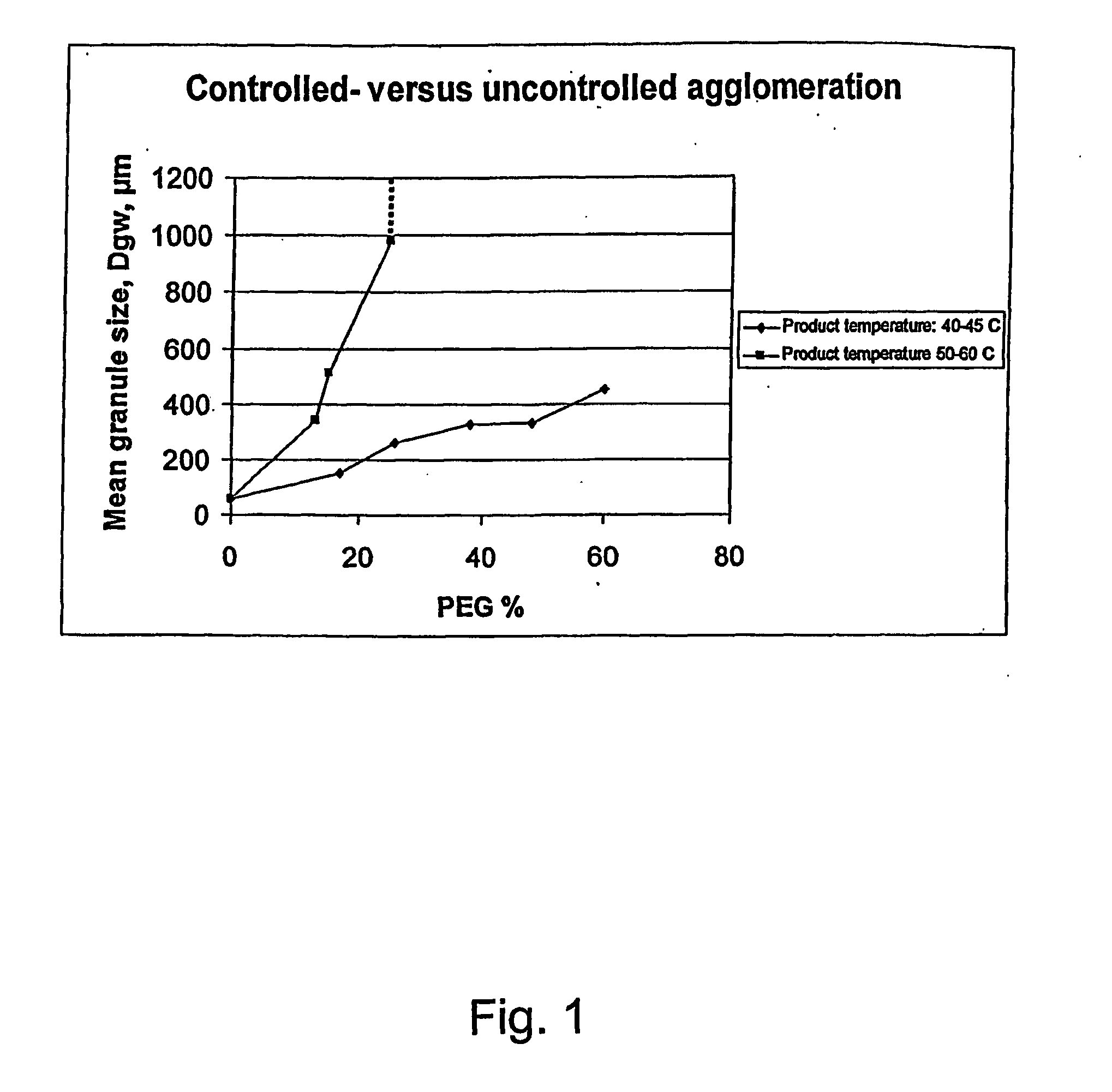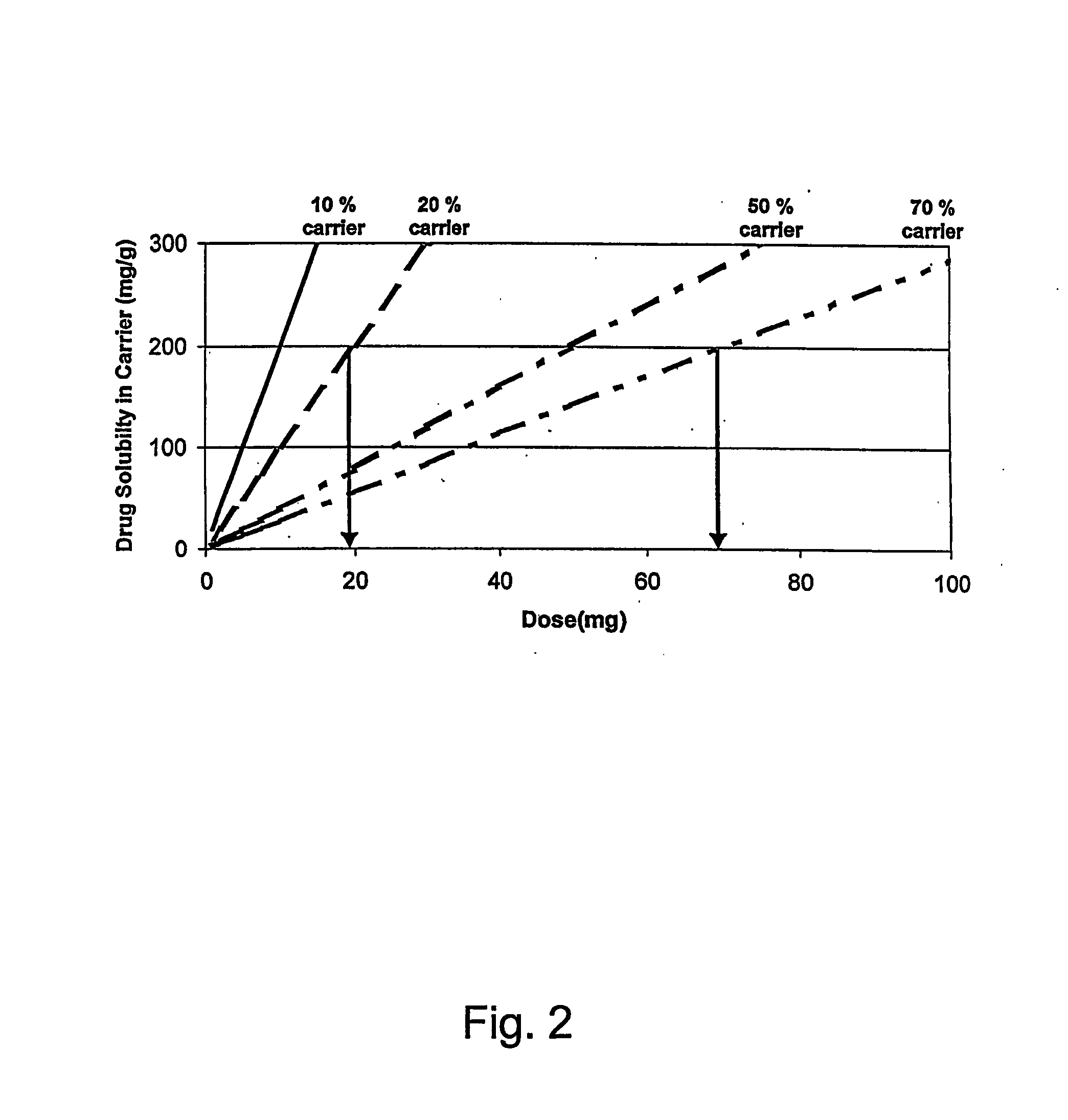Controlled agglomeration
- Summary
- Abstract
- Description
- Claims
- Application Information
AI Technical Summary
Benefits of technology
Problems solved by technology
Method used
Image
Examples
example 1
Preparation of Tablets Containing a Particulate Material According to the Invention
[0144] The example illustrates the preparation of a particulate material comprising a relatively large amount of a carrier. The particulate material obtained exhibits good flowability, good compactability and possesses excellent tabletting properties. Thus, the particulate material allow the preparation of e.g. tablets and in spite of the relatively large load of carrier the tablets display minimal, if any, adherence (sticking) to tablet punches and / or dies during compression. Furthermore, the tablets obtained have acceptable properties with respect to disintegration, weight variation and hardness.
Starting Materials
Lactose monohydrate (DMV) 125 mesh
Calcium hydrogen phosphate anhydrous (Di-Ca-Fos P)
Polyethylene glycol 6000 (PEG 6000) having a melting point of about 60° C.
Equipment
[0145] Fluid bed Strea-1 (from Aeromatic-Fielder) mounted with a special developed top-spray binary nozzle havin...
example 2
Controlled Agglomeration—Proof of Concept
Method
[0156] Controlled agglomeration is obtained by keeping the product temperature at minimum 10° C. below melting point of the carrier reducing the probability of agglomeration due to coalescence. Controlled agglomeration is characterised by gradual increase in mean granule size (geometric weight mean diameter dgw) as function of applied amount of carrier. In contrast, uncontrolled agglomeration shows rapidly increasing granule size. As a proof of concept the granule growth pattern are compared corresponding to the following conditions: [0157] Inlet fluidising air temperature of ambient temperature: 20-25° C. [0158] Inlet fluidising air temperature of 85° C. leading to a temperature of the product of about 50-60° C.,
Starting Materials
Lactose monohydrate 125 mesh
Polyethylene glycol 6000
Equipment
Fluid bed Strea-1 mounted with a top-spray binary nozzle.
Granular Compositions
Lactose 400 g
PEG 6000 Increased stepwise in separat...
example 3
Improving Tabletting Characteristics of Paracetamol Applying the Controlled Agglomeration Technique
[0162] Parcetamol has been chosen as model substance representing a substance with poor compression characteristics. By incorporation of PEG 6000 by melt spraying, i.e. spraying melted PEG 6000 on paracetamol, a granular product of paracetamol is obtained with excellent flowability and tablet compression characteristics.
In order to obtain tablets with satisfactory disintegration time Avicel PH 200 and Kollidon CL (super-disintegrant) has been added to the product
Starting Materials
Polyethyleneglycol 6000 (Hoechst)
Paracetamol (Unikem)
Equipment
Fluid bed Strea-1 (Aeromatic-Fielder)
[0163] 300 g PEG 6000 was melted by heating to 90° C. in a pressure tank. The melted carrier was pumped through a heated tube (85° C.) to the binary nozzle in the fluid bed at a tank pressure of 1.5 Bar. The atomizing air was heated to 140° C. The inlet air temperature of the flu...
PUM
| Property | Measurement | Unit |
|---|---|---|
| Temperature | aaaaa | aaaaa |
| Temperature | aaaaa | aaaaa |
| Temperature | aaaaa | aaaaa |
Abstract
Description
Claims
Application Information
 Login to View More
Login to View More - R&D
- Intellectual Property
- Life Sciences
- Materials
- Tech Scout
- Unparalleled Data Quality
- Higher Quality Content
- 60% Fewer Hallucinations
Browse by: Latest US Patents, China's latest patents, Technical Efficacy Thesaurus, Application Domain, Technology Topic, Popular Technical Reports.
© 2025 PatSnap. All rights reserved.Legal|Privacy policy|Modern Slavery Act Transparency Statement|Sitemap|About US| Contact US: help@patsnap.com



